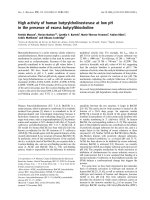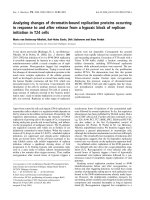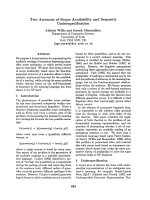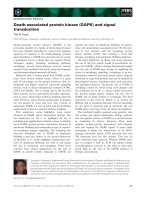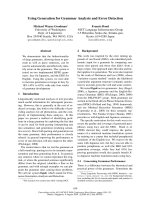Báo cáo khoa học: "Cortisol secretion after adrenocorticotrophin (ACTH) and Dexamethasone tests in healthy female and male dogs" pptx
Bạn đang xem bản rút gọn của tài liệu. Xem và tải ngay bản đầy đủ của tài liệu tại đây (273.1 KB, 6 trang )
BioMed Central
Page 1 of 6
(page number not for citation purposes)
Acta Veterinaria Scandinavica
Open Access
Research
Cortisol secretion after adrenocorticotrophin (ACTH) and
Dexamethasone tests in healthy female and male dogs
Paula Pessina*
1
, Andrea Fernández-Foren
1
, Enrique Cueto
2
, Luis Delucchi
2
,
Victor Castillo
3
and Ana Meikle
1
Address:
1
Laboratorio de Técnicas Nucleares, Facultad de Veterinaria, Montevideo, Uruguay,
2
Clínica de Pequeños Animales, Facultad de
Veterinaria, Lasplaces 1550 Montevideo, Uruguay and
3
Area de Clínica Médica de Pequeños Animales, Hospital Escuela, U. Endocrinología
Universidad de Buenos Aires, Argentina
Email: Paula Pessina* - ; Andrea Fernández-Foren - ; Enrique Cueto - ;
Luis Delucchi - ; Victor Castillo - ; Ana Meikle -
* Corresponding author
Abstract
Background: For the conclusive diagnosis of Cushing's Syndrome, a stimulating ACTH test or a
low suppressive Dexamethasone test is used. Reports in other species than the dog indicate that
plasma cortisol concentration after ACTH administration is affected by gender. We investigated
the effect of gender on the cortisol response to ACTH and Dexamethasone tests in dogs.
Methods: Seven healthy adult Cocker Spaniels (4 females and 3 males) were assigned to a two by
two factorial design: 4 dogs (2 females and 2 males) received IV Dexamethasone 0.01 mg/kg, while
the other 3 dogs received an IV saline solution (control group). Two weeks later the treatments
were reversed. After one month, ACTH was given IV (250 μg/animal) to 4 dogs (2 female and 2
males) while the rest was treated with saline solution (control group). Cortisol concentrations
were determined by a direct solid-phase radioimmunoassay and cholesterol and triglycerides by
commercial kits.
Results and Discussion: No effect of treatment was observed in metabolite concentrations, but
females presented higher cholesterol concentrations. ACTH-treated dogs showed an increase in
cortisol levels in the first hour after sampling until 3 hours post injection. Cortisol concentrations
in Dexamethasone-treated dogs decreased one hour post injection and remained low for 3 hours,
thereafter cortisol concentrations increased. The increase in cortisol levels from one to two hours
post ACTH injection was significantly higher in females than males. In Dexamethasone-treated
males cortisol levels decreased one hour post injection up to 3 hours; in females the decrease was
more pronounced and prolonged, up to 5 hours post injection.
Conclusion: We have demonstrated that cortisol response to ACTH and Dexamethasone
treatment in dogs differs according to sex.
Published: 17 August 2009
Acta Veterinaria Scandinavica 2009, 51:33 doi:10.1186/1751-0147-51-33
Received: 23 July 2009
Accepted: 17 August 2009
This article is available from: />© 2009 Pessina et al; licensee BioMed Central Ltd.
This is an Open Access article distributed under the terms of the Creative Commons Attribution License ( />),
which permits unrestricted use, distribution, and reproduction in any medium, provided the original work is properly cited.
Acta Veterinaria Scandinavica 2009, 51:33 />Page 2 of 6
(page number not for citation purposes)
Background
Cushing's Syndrome (CS) is a disorder associated with
excessive glucocorticoid production. The CS is one of the
most common endocrine pathologies in dogs [1,2]. The
excess of cortisol affects different tissues and metabolic
pathways, such as the carbohydrate and lipid pathways [3-
6]. As a result dogs show glucose intolerance, hyperglyc-
emia and hyperlipemia accompanied with an increase in
triglycerides and total cholesterol, [4,7,8] causing signs as
polyuria, polydipsia, polyphagia and abdominal enlarge-
ment. All characteristics of Cushing's Syndrome [9,10].
Even though it is possible to diagnose CS by clinical signs,
laboratory tests and radiology/ecography exams, the syn-
drome should be confirmed by hormone determination
[10]. Determination of basal cortisol is of no meaning,
levels are very variable and affected by the stress of sam-
pling. Thus, for the conclusive diagnosis a stimulating
ACTH test or a low suppressive Dexamethasone test is
used [11]. The suggested hours for sampling after ACTH
administration are 30 to 60 min post-injection and for the
low dose Dexamethasone test 3 to 4 and 8 hours after the
injection [10].
Many laboratories have established reliable reference val-
ues for cortisol concentrations in blood of clinically nor-
mal animals. However, non pathologic factors that affect
adrenocortical secretion may lead to misinterpretation of
test results. For other species (humans, ruminants) a gen-
der effect on cortisol concentrations exists [12], but in
dogs no sex effect has been found [13]. In sheep, plasma
cortisol concentrations after ACTH administration were
higher in females than in males [14]. Cortisol affects car-
bohydrate and lipid metabolism, and even if it is known
that ACTH/Dexamethasone administration affects corti-
sol levels, we found no reports on their effects on choles-
terol and triglycerides levels in dogs.
The aim of this study was to determine the effect of ACTH
and the low-dose Dexamethasone test on cortisol concen-
trations determined hourly in healthy male and female
dogs. We also investigated the effects of these tests on cho-
lesterol and triglycerides levels.
Materials and methods
Animals and blood sampling
Seven healthy adult Cocker Spaniels, 6 to 9 years of age (3
males and 4 females) were used. The mean (± SEM)
weight of these animals was 9 ± 0.7 kg. Animals were fed
with a commercial diet (Excelent, Purina, Nestlé, Buenos
Aires, Argentina) at 20:00 hours. Animal experimentation
was performed in compliance with regulations set by the
Veterinary Faculty, University of Uruguay, Uruguay.
Animal management and blood sampling was the same in
both experimental designs. Animals were catheterized in
the cephalic vein at 6:00 and blood samples were taken
every hour from 7:00 until 17:00 hours in heparinized
vials. Infusions of ACTH, Dexamethasone or saline solu-
tions were given at 9:00 (e.g. two hours after the initiation
of the blood sampling). Blood samples were centrifuged
at 3000 rpm for 15 min and plasma was stored at -20°C
until assayed.
Experimental Design 1: Low-dose Dexamethasone test
A cross-over design was performed: Dexamethasone 0.01
mg/kg (Dispert S.A., Montevideo, Uruguay) was given IV
to four dogs (2 females and 2 males), while the other 3
dogs received IV saline solution. Two weeks later, the Dex-
amethasone-treated animals received the IV saline solu-
tion, while the previous control dogs were treated with the
same Dexamethasone dose.
Experimental Design 2: ACTH test
ACTH was given IV at a dose of 250 μg/animal (Novartis
Farmaceutica LTD, England) to 4 dogs (2 females and 2
males) while the rest received saline solution (control
group).
Hormone determination
Plasma samples were assayed in the Laboratory of Nuclear
Techniques, Veterinary Faculty, Montevideo, Uruguay.
Cortisol concentrations were determined by a direct solid-
phase radioimmunoassay using DPC kits (Diagnostic
Products Corporation, Los Angeles, CA, USA). The analyt-
ical detection limit of the assay was 9.6 nmol/L. The intra-
assay coefficients of variation for low (27.6 nmol/L) and
medium controls (138.0 nmol/L) were 3.4% and 5.3%,
respectively. The inter-assay coefficients of variation for
the same controls were 8.7% and 7.6%, respectively.
Metabolite determination
The methods and commercial kits used were: Cholesterol
by enzymatic AA method (Wiener Lab 1220114, Rosario-
Argentina) and Triglycerides by GPO/PAP AA Wiener Lab
1780112, Rosario-Argentina). The standatrol was used as
an internal control (Wiener Lab 1937553, Rosario-Argen-
tina). The intra-assay coefficient of variation was below
10%.
Statistical Analyses
Cortisol, cholesterol and triglycerides concentrations were
analyzed by the mixed procedure (PROC MIXED de SAS
®
,
Statistical Analysis System, SAS Institute Inc., Cary, NC,
USA 2000). The statistical model included the effects of
treatment, gender and hour of sampling and their interac-
tions. Data are presented in graphs as least square means
± pooled standard error. Significance was considered
Acta Veterinaria Scandinavica 2009, 51:33 />Page 3 of 6
(page number not for citation purposes)
when P ≤ 0.05, and values between P > 0.05 and P < 0.1
were considered a trend.
Results
Test effect
Sampling time, treatment and their interaction had a sig-
nificant effect on cortisol concentrations (P < 0.0001 for
all effects). Cortisol concentrations in Dexamethasone
treated dogs decreased one hour post injection and
remained low for 3 hours, thereafter cortisol concentra-
tions increased. ACTH-test dogs showed an increase in
cortisol levels in the first hour after sampling until 3 hours
post injection. No differences from basal levels were
found 4 hours post injection (Figure 1). No effect of time
of sampling on cortisol levels were observed in control
dogs (Figure 1). No effect of sampling on cholesterol lev-
els were observed, but triglyceride concentrations
decreased at the end of the sampling period (Figure 2).
Gender effect
A significant interaction between sex*treatment (P <
0.0001) and sex*treatment*time of sampling (P =
0.0095) on cortisol concentrations were found. In the
Dexamethasone-treated males cortisol levels decreased
one hour post injection and returned to pre-treatment lev-
els 3 hours later. In the females the decrease was more
pronounced and prolonged, returning to pre-treatment
levels 6 hours post injection (Figure 3A). This resulted in
that cortisol levels were lower in females 4 and 5 hours
after Dexamethasone injection. The increase in cortisol
levels from one to two hours post ACTH injection was sig-
nificantly higher in females than males (P < 0.001) (Fig-
ure 3B). Control dogs did not show differences among
gender (Figure 3C).
There was an effect of gender on cholesterol and triglycer-
ides concentrations, as females had higher cholesterol lev-
els (6.2 ± 0.26 vs 5.2 ± 0.26 mmol/L, P < 0.0001) and
triglycerides concentrations (0.91 ± 0.08 vs 0.80 ± 0.07
mmol/L respectively). Since there was no effect of treat-
ment or sampling time on metabolite concentrations,
data was pooled according to gender (Figure 2).
Discussion
A circadian rhythm for cortisol secretion has been
reported for humans, monkeys and rats, but this is contra-
dictory in dogs [15-17]. In the present study, cortisol con-
centrations were measured hourly for 10 hours and no
variations were observed. No changes were found in cho-
lesterol concentrations, but triglycerides levels decreased
at the end of the experimental period probably due to the
prolonged time from the last meal (17 hours after intake).
No effect of treatment was observed in cortisol concentra-
tions. Dexamethasone-treated dogs presented a decrease
Cortisol concentrations after ACTH, Dexamethasone and Saline solution treatments in healthy Cocker Spaniel dogsFigure 1
Cortisol concentrations after ACTH, Dexametha-
sone and Saline solution treatments in healthy
Cocker Spaniel dogs.
0
50
100
150
200
250
300
350
-2-1012345678
ACT H
SALI N E
DEXA
Cortisol (nmol/L)
Hours (0=injection)
Cholesterol (A) and triglycerides (B) concentrations in healthy female and male Cocker Spaniel dogsFigure 2
Cholesterol (A) and triglycerides (B) concentrations
in healthy female and male Cocker Spaniel dogs.
Open dots: females. Solid line: males.
0,0
0,5
1,0
1,5
-202468
Cholesterol (mmol/L
)
Hours (0 = injection)
Triglycerides (mmol/L)
A
B
4,0
4,5
5,0
5,5
6,0
6,5
7,0
-2 0 2 4 6 8
Acta Veterinaria Scandinavica 2009, 51:33 />Page 4 of 6
(page number not for citation purposes)
in the first hour post injection that lasted until 3 hours
post injection. Feldman and Nelson [18] found a similar
suppression of cortisol secretion after Dexamethasone
treatment in dogs sampled hourly, although the levels
remained low up to 8 hours post injection. This difference
cannot be attributed to the dose, but it could be due to the
adjuvant and/or management of the animals (e.g., breed,
hours of fasting). Cortisol response to stimulation with
ACTH and inhibition with Dexamethasone was similar to
other reports considering not only the maximum cortisol
concentrations after treatment, but also the duration of
the response [18-20]. In the present study, ACTH-treated
dogs maintained high cortisol levels up to 3 hours post
injection; while Hansen et al (1994)[19] -sampling every
30 min- found a significant increase, similar to ours, in
the first 30 min post-injection and a maximum concentra-
tion 1.5 hours after injection. Their sampling ended at 2.5
hours and cortisol concentrations were although lower
than 1.5 hour post injection- still different from baseline.
Although our study used a small number of animals, it
should be noted that the frequent sampling and cortisol
concentrations could not be attributed to the stress of the
sampling procedure. We did not find sex differences in
basal cortisol levels, which is in agreement with Reimers
et al. 1990 [13] who did not find any effect of gender on
cortisol concentrations in healthy dogs. On the other
hand, the concentration of the precursor of cortisol cho-
lesterol was higher in female dogs than males (6.2 vs 5.2
mmol/L), in agreement with Barrie et al 1993 [21].
This study showed that gender affected the cortisol
response of the animals when stimulated with ACTH or
inhibited with Dexamethasone.
Dexamethasone inhibition of cortisol secretion differed
according to sex, as inhibition lasted longer in females
than in males. We have not found any reports on different
response by gender in Dexamethasone-treated dogs. In
humans, the glucocorticoid sensitivity measured by a Dex-
amethasone suppression test and the combined Dexame-
thasone suppression/CRH stimulation (Dex-CRH) test
used to evaluate the degree of HPA-axis dysregulation in
patients with unipolar depression have been shown to be
affected by sex [22]. Moreover, in rats, estrogen treatment
reduced type I receptors in the anterior pituitary by
5060%; this down-regulatory effect was seen only in
female rats and no change was found for males suggesting
that the regulation was steroid independent [23]. Whether
the prolonged Dexamethasone inhibition on cortisol
secretion in dogs is due to differential pituitary/hypotha-
lamus sensitivity to glucocorticoids remains to be eluci-
dated.
ACTH response in terms of cortisol secretion was also
affected by gender as females presented higher cortisol
concentrations than males. This is in agreement with
reports in other species (rat [24,25]; sheep in vitro [26];
sheep in vivo [27]). Since the treatment was with exoge-
nous ACTH, we can suggest that the peripheral response
of the adrenal glands to ACTH has a different regulation
among sexes. We have found no reports on different sen-
sitivity of the adrenal gland to ACTH in dogs. On the other
hand, we have previously shown the existence of estrogen
receptor alpha (ERα) in the sheep adrenal gland and
found a varying sensitivity to oestrogens as the ER levels
differed according to sex and gonadal status, with the ewes
having higher ER levels than rams [27]. These findings
indicate that oestrogens most likely affect steroidogenesis
directly at the adrenal cortex and suggest that oestrogens
are partly responsible for the sex differences in cortisol
secretion in sheep. Possible mechanisms by which oestro-
Cortisol concentrations in female and male healthy Cocker Spaniel dogs after Dexamethasone (A), ACTH (B) and Saline solution (C) treatmentsFigure 3
Cortisol concentrations in female and male healthy
Cocker Spaniel dogs after Dexamethasone (A),
ACTH (B) and Saline solution (C) treatments.
Observe that the scale in B panel is different from A and C
panels. Open dots: females. Solid line: males.
Cortisol (nmol/L)
Hours (0=injection)
80
100
60
0
40
20
100
80
60
40
20
0
400
300
200
100
0
-2 -1 0 1 2 3 4 5
6
78
A
B
C
Acta Veterinaria Scandinavica 2009, 51:33 />Page 5 of 6
(page number not for citation purposes)
gens might affect adrenal steroidogenesis have been sug-
gested: influence on adrenocortical sensitivity to ACTH
[28,29]; stimulatory effect on the induction of enzymes in
the synthesis of glucocorticoids [30]; and/or increase in
availability of steroid precursor (cholesterol) by affecting
the steroidogenic acute regulatory (StAR) protein [31,32].
In this study the plasma concentrations of the steroid pre-
cursor cholesterol in female dogs was higher than in
males (Figure 2A), as previously shown in the Beagle
breed [33]. This finding suggests that the higher cortisol
levels found in females after ACTH test is due -at least par-
tially- to a higher availability of its precursor: cholesterol.
We have not found any studies on the mechanisms by
which oestrogens participate in the regulation of adrenal
cortex functions, e.g. cortisol secretion, in dogs.
Conclusion
In summary, we have demonstrated that the cortisol
response to ACTH and Dexamethasone treatment in dogs
differs according to sex.
Abbreviations
ACTH: adrecorticotropin; CS: Cushing's Syndrome.
Competing interests
The authors declare that they have no competing interests.
Authors' contributions
PP lead the experimental designs and drafted the manu-
script. AFF carried out the inmunoassays and metabolites
assays. EC and LD contributed with the experimental
designs. VC contributed with the interpretation of the
data and correction of the manuscript. AM performed the
statistical análisis and helped to draft the manuscript. All
authors read and approved the final manuscript.
Acknowledgements
We acknowledge Prof. Dr. Elize van Lier for the constructive criticism of
this manuscript. Thanks to Marlene Gomez Porto for her technical support.
References
1. Feldman EC: Comparison of ACTH response and Dexameth-
asone suppression as screening test in canine hyperadreno-
corticism. J Am Vet Med Assoc 1983, 182:506-510.
2. Zerbe CA: Differentiating tests to evaluate hyperadrenocor-
ticism in dogs and cats. Small Animal/Exotics 2000, 22:149-158.
3. Rijnberk A: Clinical Endocrinology of dogs and cats. Kluwer:
Academic Pub, The Netherlands; 2002.
4. Beale EG, Hamme RE, Antoine B, Forest C: Disregulated glycero-
neogenesis: PCK1 as a candidate diabetes and obesity gene.
Trends Endocrinol Metab 2004, 15:129-135.
5. Wake DJ, Walker BR: 11-Hydroxysteroid dehydrogenase type
1 in obesity and the metabolic syndrome. Mol Cell Endocrinol
2004, 215:45-54.
6. Klein J, Perwitz N, Kraus D, Fasshauer M: Adipose tissue as source
and target for novel therapies. Trends Endocrinol Metab 2006,
17:26-32.
7. Ling GV, Stabenfeldt GH, Comer KM, Gribble DH, Schechter RD:
Canine hyperadrenocorticism: pretreatment clinical and
laboratory evaluation of 117 cases. J Am Vet Med Assoc 1979,
174:1211-1215.
8. Boscaro M, Barzon L, Fallo F, Sonino N: Cushing's syndrome. Lan-
cet 2001, 357:783-791.
9. Kooistra HS: The Diagnostic Approach of Hypercortisolism in
Dogs and Cats. 31st World Small Animal Veterinary Congress 2006;
October 1114, Prague, Czech Repulic .
10. Herrtage M: Hiperadrenocorticismo canino. En Manual de
Endocrinología en pequeños animales. 3rd edition. Edited by:
Mooney CT y Peterson ME. Industrias Gráficas Ferre Olsina, España;
2007:217-247.
11. Behrend EN, Kemppainen RJ: Diagnosis of Canine Hyperadreno-
corticisim. Vet Clin North Am Small Anim Pract 2001, 31:985-1003.
12. Woods SC, Gotoh K, Clegg DJ: Gender difference in the control
of energy homeostasis. Exp Biol Med (Maywood) 2003,
228:1175-1180.
13. Reimers TJ, Lawler DF, Sutaria PM, Correa MT, Erb HN: Effects of
age, sex, and body size on serum concentrations of thyroid
and adrenocortical hormones in dogs. Am J Vet Res 1990,
51:
454-457.
14. van Lier E, Pérez-Clariget R, Forsberg M: Sex differences in corti-
sol after administration of an ACTH analogue in sheep dur-
ing the breeding and non breeding season. Anim Reprod Sci
2003, 79:81-92.
15. Kemppainen RJ, Sartin RL: Evidence for episodic but not circa-
dian activity in plasma concentrations of adrenocortico-
trophin, cortisol and thyroxine in dogs. J Endocrinol 1984,
103:219-225.
16. Orth DN, Peterson ME, Drucker WD: Plasma immunoreactive
proopiomelanocortin peptides and cortisol in normal dogs
and dogs with Cushing's syndrome: diurnal rhythm and
responses to various stimuli. Endocrinol 1988, 22:1250-1262.
17. Castillo VA, Cabrera Blatter MF, Gómez NV, Sinatra V, Gallelli MF,
Ghersevich MC: Diurnal ACTH and plasma cortisol varations
in healthy dogs and in those with pituitary-dependent Cush-
ing's syndrome before and after treatment with retinoic
acid. Res Vet Sci 2009, 86:223-229.
18. Feldman EC, Nelson RW: Hiperadrenocorticism canine (Cush-
ing's Syndrome). In Canine and feline endocrinology and reproduction
Volume Chapter 6. 3rd edition. Edited by: Feldman EC, Nelson RW.
Inter-Médica, Buenos Aires, República Argentina; 2007:341-345.
19. Hansen B, Kemppainen RJ, MacDonald JM: Synthetic ACTH
(Cosyntropin) stimulation test in normal dogs: Comparison
of intravenous and intramuscular administration. J Am Anim
Hosp Assoc 1994:30-38.
20. Peterson ME, Wallace MS, Kerl ME: Dose-response relation
between plasma concentrations of ACTH and cortisol after
administration of incremental doses of cosyntropin for
ACTH stimulation testing in dogs [abstract]. J Vet Intern Med
1996, 10:186.
21. Barrie J, Watson TDG, Stear MJ, Nash AS: Plasma cholesterol and
lipoprotein concentrations in the dog: The effects of age,
breed, gender and endocrine disease. J Small Anim Pract 1993,
34:507-512.
22. Binder EB, Künzel HE, Nickel T, Kern N, Pfennig A, Majer M, Uhr M,
Ising M, Holsboer F: HPA-axis regulation at in-patient admis-
sion is associated with antidepressant therapy outcome in
male but not in female depressed patients. Psychoneuroendo-
crinology 2009, 34:99-109.
23. Ferrini M, Magariños AM, De Nicola AF:
Oestrogens down-regu-
late type I but not type II adrenal corticoid receptors in rat
anterior pituitary. J Steroid Biochem 1990, 35:671-677.
24. Kitay JI: Sex differences in adrenal cortical secretion in the
rat. Endocrinology 1961, 68:818-824.
25. Handa RJ, Burgess LH, Kerr JE, O'Keefe JA: Gonadal steroid hor-
mone receptors and sex differences in the hypothalamo-
pituitary-adrenal axis. Horm Behav 1994, 28:464-476.
26. Canny BJ, O'Farrell KA, Clarke IJ, Tilbrook AJ: The influence of sex
and gonadectomy on the hypothalamo-pituitary-adrenal
axis of the sheep. J Endocrinol 1999, 162:215-225.
27. van Lier E, Meikle A, Bielli A, Akerberg S, Forsberg M, Sahlin L: Sex
differences in oestrogen receptor levels in adrenal glands of
sheep during the breeding season. Domest Anim Endocrinol 2003,
25:373-387.
28. Atkinson HC, Waddell BJ: Circadian variation in basal plasma
corticosterone and adrenocorticotropin in the rat: sexual
dimorphism and changes across the estrous cycle. Endocrinol-
ogy 1997, 138:3842-3848.
Publish with BioMed Central and every
scientist can read your work free of charge
"BioMed Central will be the most significant development for
disseminating the results of biomedical research in our lifetime."
Sir Paul Nurse, Cancer Research UK
Your research papers will be:
available free of charge to the entire biomedical community
peer reviewed and published immediately upon acceptance
cited in PubMed and archived on PubMed Central
yours — you keep the copyright
Submit your manuscript here:
/>BioMedcentral
Acta Veterinaria Scandinavica 2009, 51:33 />Page 6 of 6
(page number not for citation purposes)
29. Lo MJ, Chang LL, Wang PS: Effect of estradiol on corticosterone
secretion in ovariectomized rats. J Cell Biochem 2000,
77:560-568.
30. Perry JE, Stalvey JRD: Gonadal steroids modulate adrenal fas-
ciculata 3 beta-hydroxysteroid dehydrogenaseisomerase
activity in mice. Biol Reprod 1992, 46:73-82.
31. Townson DH, Wang XJ, Keyes PL, Kostyo JL, Stocco DM: Expres-
sion of the steroidogenic acute regulatory protein in the cor-
pus luteum of the rabbit: dependence upon the luteotropic
hormone, estradiol-17 beta. Biol Reprod 1996, 55:868-874.
32. Stocco DM: StAR protein and the regulation of steroid hor-
mone biosynthesis. Annu Rev Physiol 2001, 63:193-213.
33. Kaspar LV, Norris WP: Serum chemistry values of normal dogs
(beagles): associations with age, sex, and family line. Lab Anim
Sci 1977, 27:980-985.

